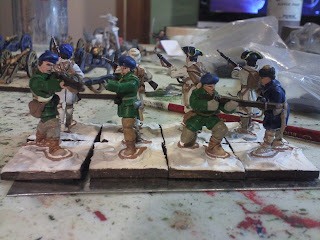The primary activity that lured me into miniature wargaming was the reading I did as a kid. Growing up in the 1960's, was a golden age for books about WWII and I read a lot of them. That war seemed just a stones throw away. The TV shows Combat and Twelve O'Clock High were drama staples. Several of my friends had fathers who were WWII combat veterans. And we were getting just far away from the war that we could laugh with McHale's Navy and Hogan's Heroes.
I was reading the abridged Official Marine Corps History of World War II,
Incredible Victory by Walter Lord, and
Midway: The Battle that Doomed Japan by Mitsuo Fuchida. These were books that revealed the disasters and triumphs of Japan and America in the Pacific and opened my eyes to the suffering and struggle of those who fought there. Oops, left out The Two Ocean War by Samuel Eliot Morrison. I read my little paperback so many times, it literally fell apart.
Forty years later and there are generations of new books about those same campaigns and battles, seen with new information and fresh eyes. Neither of the books I'm about to recommend are brand new, hot off the shelf.
The Shattered Sword: The Untold Story of the Battle of Midway was published in 2005, but does offer a completely different version of Midway than was told before. James Hornfischer's book, Neptune's Inferno is new this year. It's not so much that the story hasn't been told, it's the quality of the telling that makes it such a great read.
Jonathan Parshall and Anthony Tully's
Shattered Sword is a remarkable analysis of the June 1942 carrier victory that halted Japanese expansion in the Central Pacific. It is an interesting revision of the story that's always been told. Parshall and Tully systematically dismantle old perceptions of the battle based, largely, on Fuchida's book, written in the 50's. Together, they submit a picture of the battle that is very Keeganesque in its approach. In their analysis of the Japanese battle plan and its execution they examine philosophy, doctrine, and decision-making as well as a step by step look at the "battle piece." If you read military history for analysis of those decisions, this is the book for you.
Without giving too much away, Parshall and Tully deconstruct the Fuchida story, suggesting the Japanese battle plan went way past the "victory disease" affliction he and others have attributed to Yamamoto and other planners. He further suggests that the Americans, with their sizable air corps on unsinkable Midway Island, combined with their three carrier aircraft outnumbered the Japanese planes available. Yamamoto's failure to include all six fleet carriers in his attack was a major failing. Deconstructing the battle moment, by moment, they state Fuchida's contention the Japanese flight decks were full of armed planes at the time of the American attack was a fiction, that they were being armed below decks in the hangars, and were not "spotted" or being rushed to the flight deck for launch. They devote much time at the end of the book to point fingers, and there are plenty to go around Japanese and American. Very readable and very interesting.
Yesterday I finished reading James Hornfischer's most recent book, Neptune's Inferno. Focused on the naval actions at Guadalcanal, the book has earned mixed reviews for offering little new on the topic. Hornfischer's previous books were
Last Stand of the Tin Can Sailors, on the Battle off Samar at Leyte Gulf, and
Ship of Ghosts on the U.S.S. Houston.
Last Stand is one of the best books I've ever read, period.
In Neptune's Inferno, Hornfischer takes on a more expansive topic, focusing on the six month naval campaign to supply and support the Marines on Guadalcanal. From the planning to the actions at Savo Island, the East Solomons battle, Cape Esperance, Santa Cruz, the night actions of Nov. 12-14th, and the disaster at Tassafronga, Hornfischer paints a gruesome picture of war at sea. From both a sailor's view, and from a commander's eye, we get a look inside this desperate struggle in the Pacific as the United States wrested naval dominance from the Japanese at a terrible cost.
As a casual reader of World War II topics, I learned a lot. The real strength of this book, however, is Hornfischer's gift for narration. Regardless whether there is lots new here or not, the author's storytelling ability helps the reader understand the subject in bolder relief than before.



































































